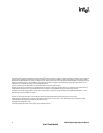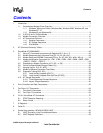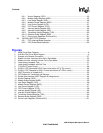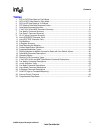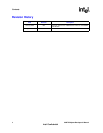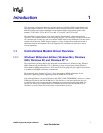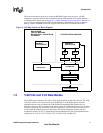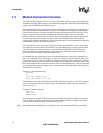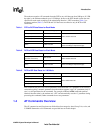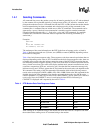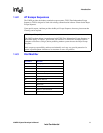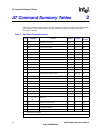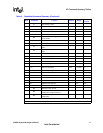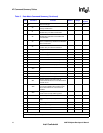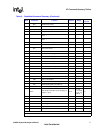
10 536EX Chipset Developer’s Manual
Intel Confidential
Introduction
1.3 Modem Connection Overview
The DCE (modem) operates in one of two states: command or online. In each state, both data and
commands (including DCE responses) are transferred through the UART THR (Transmit Holding
register) and the RBR (Receiver Buffer register).
The modem defaults to the command state. In the command state, the DTE (host) communicates to
the modem through AT commands and S-registers. AT commands are character strings that help
guide modem operation. S-registers are internal modem registers that the DTE can access. The S-
registers contain modem status and configuration information. Many of the AT commands
indirectly affect the contents of the S-registers. The AT command set and S-registers are divided
into the following modes: Group 3 fax, data, V.44/V.42 bis/V.42/MNP, and voice. Note that
supported AT commands are firmware revision-dependent (that is, not all commands are supported
by all modem models or all firmware revisions).
All command lines sent to the modem, except for A/, must be preceded by an ‘AT’ (which stands
for ‘attention’) and terminated by the contents of S-register S3 (typically a carriage return <CR>).
The ‘AT ’ prompts the modem to receive a command line from the DTE. A <CR> informs the
modem that the entire command string has been transmitted and that the modem should start
processing all the commands within the command line.
A command line may include one or more AT commands that may or may not be separated by a
space. AT commands may be either upper- or lower-case characters, but all characters for a given
command must use the same case. If there are multiple commands in a line, a semicolon (;) must be
placed after each fax or voice command. The modem can be configured to send back (echo) to the
DTE any data that the DTE sends to the modem (while in command state only). The last command
may be repeated by typing A/ without using a carriage return. Each command line may include up
to 80 characters and spaces.
Examples of AT command strings:
ATS1?<CR>
A/
AT &C1 &D2 +FCLASS=? <CR>
AT &C1 &D2 +FCLASS=?; S0=1 <CR>
The modem provides status information to the DTE in the form of response codes. These response
codes can be expressed in text or numeric form. The supported response codes are provided in
Table 4 on page 12.
Examples of modem responses:
+MCR: V90
+MRR: 28800
CONNECT 50666
In the online state, the DCE is off-hook and communicating with a remote modem. Any data sent
from the DTE to the DCE is transmitted to the remote modem. Similarly, any data that the DCE
receives from the remote modem is transmitted to the DTE.
Note: In the online state, the DCE does not ‘echo-back’ any of the data that the DTE sent to the DCE.



